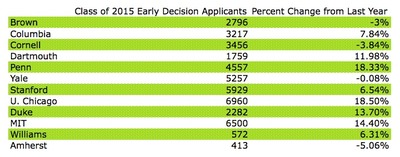 It’s the Christmas season, which in the shallow world of competitive college admissions can mean only one thing: time to compare early admissions numbers! Jacques Steinberg ’88 at the New York Times has been dutifully compiling a very helpful spreadsheet of results from this year’s round of early decision admissions decisions at various schools. Although much of the hoopla over these numbers focuses on the rate of selectivity for early decision/early action, those figures seem considerably less interesting than the raw numbers of early applicants to Dartmouth and its major competitors, along with the rate of change from last year (shown above). Selectivity at each school can’t really be measured until regular admissions decisions have been made.
It’s the Christmas season, which in the shallow world of competitive college admissions can mean only one thing: time to compare early admissions numbers! Jacques Steinberg ’88 at the New York Times has been dutifully compiling a very helpful spreadsheet of results from this year’s round of early decision admissions decisions at various schools. Although much of the hoopla over these numbers focuses on the rate of selectivity for early decision/early action, those figures seem considerably less interesting than the raw numbers of early applicants to Dartmouth and its major competitors, along with the rate of change from last year (shown above). Selectivity at each school can’t really be measured until regular admissions decisions have been made.
Dartmouth’s admissions office is justifiably happy about this year’s round of early decision applications. Early applications were up almost 12%, while early applications at three Ivies — Brown, Cornell, Yale — declined. In terms of percentage increase, Dartmouth also outperformed Columbia, Stanford, Williams, and Amherst. Meanwhile, Chicago, Penn, MIT, and Duke saw surges of new early applicants.
Yet even as early applications to Dartmouth rose this year, the College on the Hill has some catching up to do with its peers. If early admissions figures are a rough indicator of applicants’ first-choice colleges, then it would seem that Dartmouth isn’t the first choice of very many high school seniors. 1759 applicants may be an all-time high for Dartmouth, but that’s still pretty anemic, especially compared against Yale (5257), Stanford (5929), or Chicago (6960).
When you break down the numbers as compared to the respective size of each school’s total undergraduate population, the difference is still pronounced. Dartmouth’s 1759 early applicants measure up against a student body of roughly 4100, meaning that this year there were about 0.43 early applicants for every undergraduate at Dartmouth. Meanwhile, there were 0.9 early applicants for every undergraduate at Stanford, 1 early applicant for every undergraduate at Yale, and 1.35 early applicants for every undergraduate at the University of Chicago. (This is impressive, considering Chicago’s reputation as a school “where fun goes to die.”)
Why isn’t Dartmouth more popular as a first-choice college? It enjoys great stature as a provider of undergraduate education. Dartmouth is a fun place. Its rural setting isn’t necessarily for everyone, but could our remote location be the full explanation?
My own gut feeling — supported solely by anecdote — is that Dartmouth suffers from a major name-recognition gap with other Ivies and schools like Stanford and Duke, which get a big boost from their Division I athletic programs. When I go home to Texas, I find that very many college-educated adults have never heard of Dartmouth, much less know where it is or what it’s about. Making Dartmouth the first choice of more college-bound high schoolers may require making Dartmouth more of a household name. Greater name recognition would be a victory not only for Dartmouth, but also for the kind of undergraduate-focused, liberal arts education that Dartmouth provides.
— Charles S. Dameron

Be the first to comment on "An Update on the Early Decision Sweepstakes"